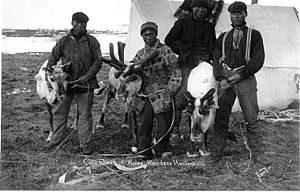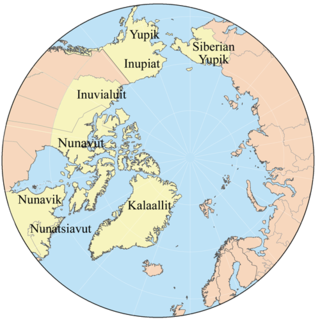
Eskimo is an exonym used to refer to two closely related Indigenous peoples: the Inuit and the Yupik of eastern Siberia and Alaska. A related third group, the Aleut, which inhabit the Aleutian Islands, are generally excluded from the definition of Eskimo. The three groups share a relatively recent common ancestor, and speak related languages belonging to the Eskaleut language family.
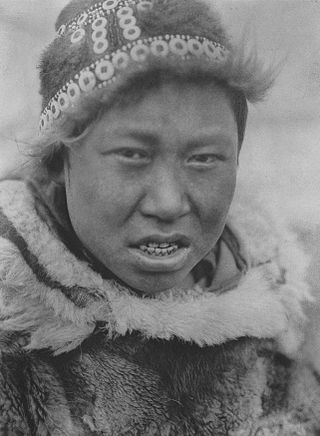
The Yupik are a group of indigenous or aboriginal peoples of western, southwestern, and southcentral Alaska and the Russian Far East. They are related to the Inuit and Iñupiat. Yupik peoples include the following:

Savoonga is a city in Nome Census Area, Alaska. It is located on St. Lawrence Island in the Bering Sea. As of the 2020 census, Savoonga's population was 835, up from 671 in 2010.

The Iñupiat are a group of indigenous Alaskans whose traditional territory roughly spans northeast from Norton Sound on the Bering Sea to the northernmost part of the Canada–United States border. Their current communities include 34 villages across Iñupiat Nunaat, including seven Alaskan villages in the North Slope Borough, affiliated with the Arctic Slope Regional Corporation; eleven villages in Northwest Arctic Borough; and sixteen villages affiliated with the Bering Straits Regional Corporation. They often claim to be the first people of the Kauwerak.

A sled dog is a dog trained and used to pull a land vehicle in harness, most commonly a sled over snow.

St. Lawrence Island is located west of mainland Alaska in the Bering Sea, just south of the Bering Strait. The village of Gambell, located on the northwest cape of the island, is 50 nautical miles from the Chukchi Peninsula in the Russian Far East. The island is part of Alaska, but closer to Russia and Asia than to the Alaskan and North American mainland. St. Lawrence Island is thought to be one of the last exposed portions of the land bridge that once joined Asia with North America during the Pleistocene period. It is the sixth largest island in the United States and the 113th largest island in the world. It is considered part of the Bering Sea Volcanic Province. The Saint Lawrence Island shrew is a species of shrew endemic to St. Lawrence Island. The island is jointly owned by the predominately Siberian Yupik villages of Gambell and Savoonga, the two main settlements on the island.
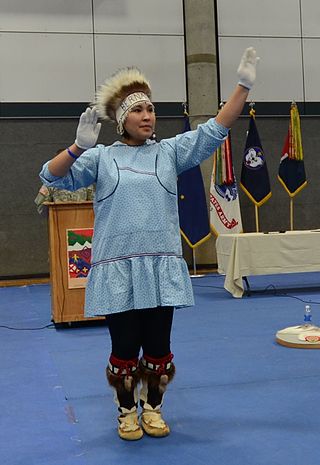
Alaska Natives are the indigenous peoples of Alaska and include Iñupiat, Yupik, Aleut, Eyak, Tlingit, Haida, Tsimshian, and a number of Northern Athabaskan cultures. They are often defined by their language groups. Many Alaska Natives are enrolled in federally recognized Alaska Native tribal entities, who in turn belong to 13 Alaska Native Regional Corporations, who administer land and financial claims.
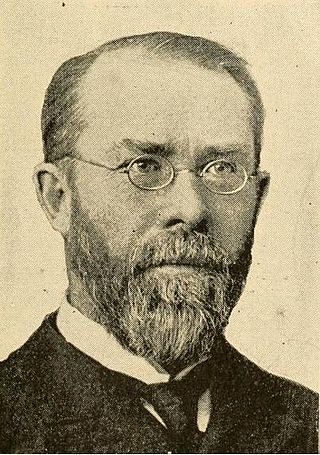
Sheldon Jackson was a Presbyterian minister, missionary, and political leader. During this career he travelled about one million miles and established more than one hundred missions and churches, mostly in the Western United States. He performed extensive missionary work in Colorado and the Alaska Territory, including his efforts to suppress Native American languages.
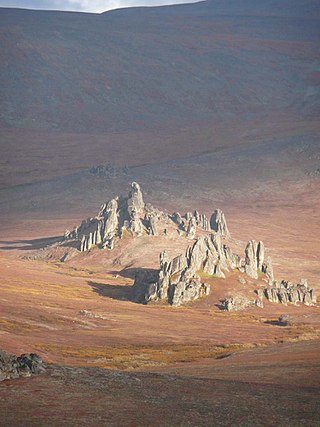
The Bering Land Bridge National Preserve is one of the most remote Protected areas of the United States, located on the Seward Peninsula. The National Preserve protects a remnant of the Bering Land Bridge that connected Asia with North America more than 13,000 years ago during the Pleistocene ice age. The majority of this land bridge now lies beneath the waters of the Chukchi and Bering Seas. During the glacial epoch this bridge was a migration route for people, animals, and plants whenever ocean levels fell enough to expose the land bridge. Archeologists disagree whether it was across this Bering Land Bridge, also called Beringia, that humans first migrated from Asia to populate the Americas, or whether it was via a coastal route.

The Porcupine caribou(Rangifer tarandus groenlandicus) is a herd or ecotype of barren-ground caribou, the subspecies of the reindeer or caribou found in Alaska, United States, and Yukon and the Northwest Territories, Canada. A recent revision changes the Latin name; see Taxonomy.
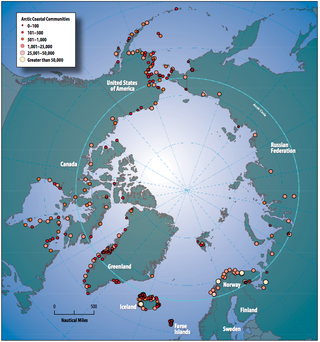
Circumpolar peoples and Arctic peoples are umbrella terms for the various indigenous peoples of the Arctic.
The Overland Relief Expedition, also called the Alaska Relief Expedition or Point Barrow-Overland Relief Expedition, was an expedition in the winter of 1897–1898 by officers of the United States Revenue Cutter Service to save the lives of 265 whalers trapped in the Arctic Ocean by ice around their ships near Point Barrow, Alaska.

William Thomas Lopp, known better professionally as W. T. Lopp, and to his family as Tom Lopp, was a member of the Overland Relief Expedition in Alaska, then a U.S. territory. He was a missionary and advocate of turning native hunters into self-sufficient reindeer herders. Lopp Lagoon, an 18 mi. long bay near where Lopp lived in Alaska, is named after him.

Indigenous peoples of the Subarctic are the aboriginal peoples who live in the Subarctic regions of the Americas, Asia and Europe, located south of the true Arctic. This region includes the interior of Alaska, the Western Subarctic or western Canadian Shield and Mackenzie River drainage area, the Eastern Subarctic or Eastern Canadian Shield, Scandinavia, Western Russia and East Asia. Peoples of subarctic Siberia and Greenland are included in the subarctic; however, Greenlandic Inuit are usually classified as Indigenous peoples of the Arctic.

The Reindeer Act or Reindeer Industry Act of 1937 is a United States federal law passed in 1937 by the U.S. Congress and signed into law by President Franklin D. Roosevelt on September 1 of that year. The act effectively prohibited the ownership of reindeer herds in Alaska by non-Native Americans. The act was intended to provide for Alaskan natives and to allow them to establish a self-sustaining industry. Authority to promulgate rules regarding the ownership and maintenance of reindeer herds was delegated to the Bureau of Indian Affairs via the Secretary of the Interior, who banned most transactions to non-natives.
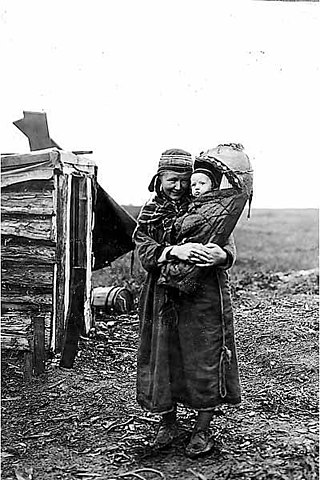
Sámi Americans are Americans of Sámi descent, who originate from Sápmi, the northern regions of Norway, Sweden, Finland, and the Kola Peninsula of Russia. The term Lapp Americans has been historically used, though lapp is considered derogatory by the Sámi.

Changunak Antisarlook Andrewuk was a Inupiaq businesswoman who became one of the richest women in Alaska due to her work in the reindeer industry.
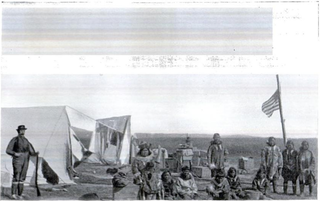
Teller Reindeer Station was located near Teller in the U.S. state of Alaska. The idea of transporting domestic reindeer from Siberia to western Alaska was first suggested by Captain Michael A. Healy, an officer in the United States Revenue Cutter Service, as a possible solution to the Native Alaskans' food shortage problem. The station was established in 1892 by Sheldon Jackson, Commissioner of Education in Alaska and a Presbyterian minister, who named it in honor of Henry M. Teller. The U.S. Government's Alaska Reindeer Service program ended in the early 1900s.

The St. Lawrence Island famine killed around 1000 people on St. Lawrence Island in the Bering Sea off the Alaskan mainland during the years 1878–1880. Possible causes may have been overfishing, disease, or negative aspects of settler contact.

The reindeer is a widespread and numerous species in the northern Holarctic, being present in both tundra and taiga. Originally, the reindeer was found in Scandinavia, eastern Europe, Russia, Mongolia, and northern China north of the 50th latitude. In North America, it was found in Canada, Alaska, and the northern contiguous USA from Washington to Maine. In the 19th century, it was apparently still present in southern Idaho. It also occurred naturally on Sakhalin, Greenland, and probably even in historical times in Ireland. During the late Pleistocene era, reindeer were found further south, such as at Nevada, Tennessee, and Alabama in North America and Spain in Europe. Today, wild reindeer have disappeared from many areas within this large historical range, especially from the southern parts, where it vanished almost everywhere. Populations of wild reindeer are still found in Norway, Finland, Siberia, Greenland, Alaska, and Canada.
